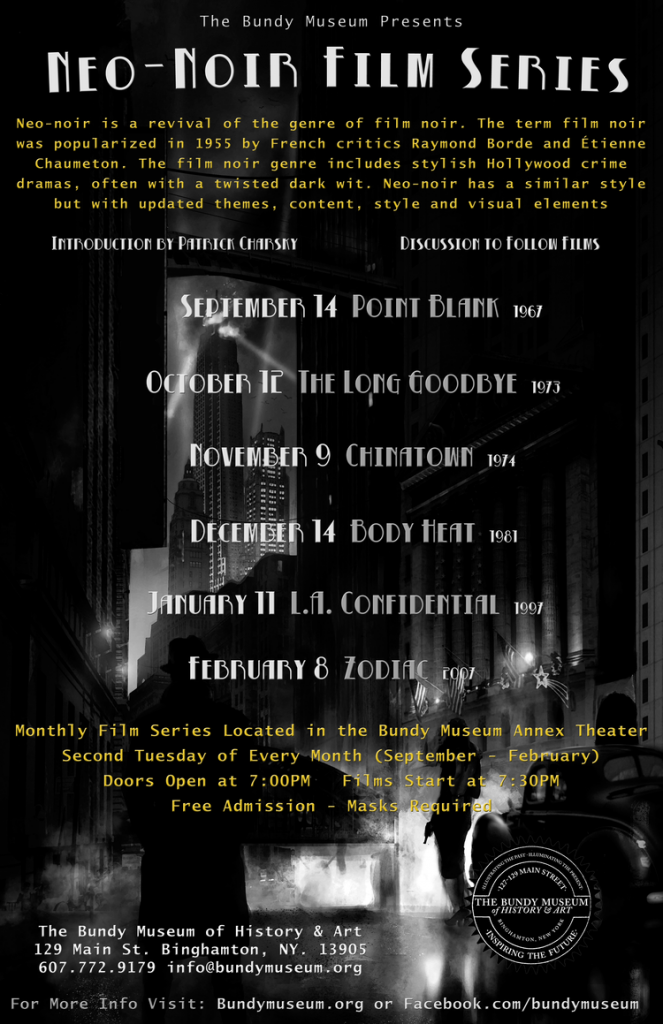Every second Tuesday of the month, the Bundy Museum of History and Art in Binghamton will hold a showing of a different neo-noir film at 7:30 p.m. — with masks required — as a part of its “Neo-Noir Film Series.” Doors open at 7 p.m. and moviegoers can remain for a post-film discussion to unpack the weight of each film.
The genre of neo-noir developed from a cinematic style known as film noir, which emphasizes darker themes. Neo-noir films are often associated with other genres such as crime, mystery or thriller. The Bundy Museum of History and Art’s film series assembles a heavy-hitting chronological lineup of films, documenting how the style has progressed. The Bundy Museum of History and Art showed the 1967 film “Point Blank” in September, a classic crime film that helped jump-start the genre. On Oct. 12, there will be a showing of the 1973 film “The Long Goodbye,” directed by Robert Altman. This film explores themes of intrigue and betrayal as well as the limits of human morals. On Nov. 9, Jack Nicholson will take to the screen in Roman Polanski’s “Chinatown,” which was nominated for 11 Oscars and won Best Original Screenplay for its script written by Robert Towne. The film, “Body Heat,” a sexy and unscrupulous story released in 1981, takes the stage on Dec. 14. “Body Heat” features William Hurt, Kathleen Turner and Ted Danson. On Jan. 11, the 1997 film “L.A. Confidential” will make its appearance, complete with a star-studded cast. With the likes of Russell Crowe, Kim Basinger and Danny DeVito, the film managed to win two of the nine Oscars it was nominated for, despite going up against “Titanic.” The final film, showing on Feb. 8, is David Fincher’s “Zodiac,” released in 2007. The movie is loosely based on the true events of the serial killer who would place encrypted messages about his victims in newspaper columns. Jake Gyllenhaal, Mark Ruffalo and Robert Downey Jr. play riveting characters that bring the stomach-churning and mind-bending historical events to audiences everywhere.
Patrick Charsky, an organizer of the “Neo-Noir Film Series,” will lead discussions for the film showings. As a screenwriter, Charsky used to hold a screenwriter’s group at the now-closed ART Mission and Theater. Closed in 2017, the ART Mission was a small theater that would show foreign and indie films in Binghamton. Charsky noted that residents of Binghamton would have to go as far as Ithaca to watch an indie or foreign film in theaters. He said he was inspired to start the series because of his own personal interest in cinema and the desire to share it with others.
“I consider myself a real cineast, an appreciator of film, so I like to show films and talk with people about them,” Charsky said. “You know, engage the community, try to get people to take an interest in films that aren’t just the franchise tent-pole films.”
According to Charsky, these “franchise tent-poles” are movies that set up a framework for an entire lucrative network of related, plot-driven movies. He said this type of movie is enticing for filmmakers and marketers but raises some concerns.
“With the closure of the ART Mission [and] Theater, there was kind of a void, I would say, for filmmaking that’s not just a business but also an art form,” Charsky said.
There is a balance between wanting to create a film that will make money as well as respect and invigorate the art of filmmaking, according to Charsky. The “Neo-Noir Film Series” at the Bundy Museum of History and Art will articulate a dark, artistic sensibility that draws out the complexity of characters, often spotlighting the internal conflict of antiheroes in morally ambiguous situations. The films are meant to incite introspection as well as promote an understanding of societal ills. Despite their seriousness, though, these films are also simply fun to engage with and discuss with other people. The monthly series is an invitation for those who are looking to connect with others over an entertaining piece of art — a kind of connection which Charsky hopes can fill the void that places like the ART Mission and Theater left behind.



